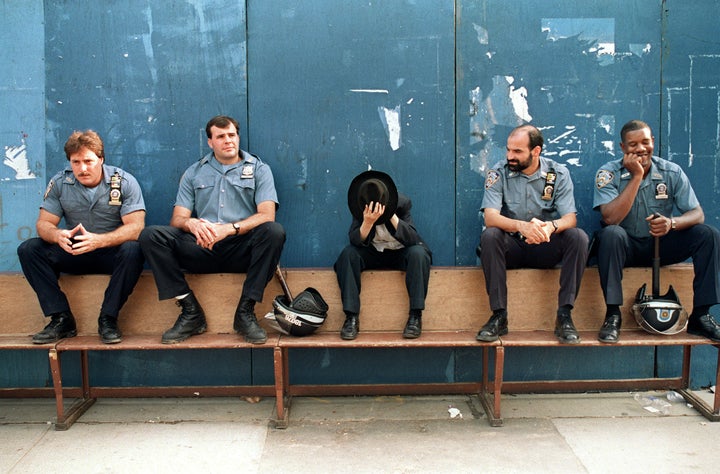
In an Aug. 9 opinion piece in The New York Jewish Week, journalism professor Ari Goldman reignites an old debate about the violence that rocked the Brooklyn neighborhood of Crown Heights 20 years ago this week, in August of 1991. It's an honest debate, reflecting deeply held views of a complex conflict.
Unfortunately, Goldman has passed off a partial -- and partisan -- perspective on this conflict as objective, journalistic truth. Goldman makes important points in his essay, but his inability to understand the limits of his own perspective does a terrible disservice to the conversation about Crown Heights that has reemerged around this anniversary. In order to understand how, we need to back up and examine the violence of 1991, as well as the "riot" and "pogrom" narratives of this violence.
The violence in Crown Heights began on the evening of Aug. 19, 1991, with the deaths of a 7-year-old Guyanese boy named Gavin Cato and a 29-year-old Orthodox Jew named Yankel Rosenbaum -- the former struck by a car in the motorcade of the Lubavitcher Rebbe (the spiritual and temporal leader of the Lubavitch Hasidic community), and the latter stabbed by a Black rioter hours later. Over the next three days, Blacks and Jews faced off in angry demonstrations, hurling rocks, bottles, slogans and slurs. A half-dozen stores were looted, and a few Black youths assaulted Jews, journalists and police.
In the years that followed, the dramatic story of "Crown Heights" became a potent symbol of communal conflict in New York and throughout the United States. On the streets of Crown Heights, however, few could agree about the nature of this conflict.
As I argue in my 2006 book, "Race and Religion Among the Chosen Peoples of Crown Heights," most Jewish Crown Heights residents experienced this violence as a "pogrom" motivated by baseless gentile hostility toward Jews, while most black Crown Heights residents experienced the same violence as a "riot" motivated by pent-up black frustration at white privilege. These conflicting narratives of the violence of 1991 fit, and confirmed, much broader understandings of black-Jewish difference as a religious difference between Jews and gentiles or, alternatively, a racial difference between blacks and whites. These differing perceptions became clear to me through scores of interviews with a broad range of Crown Heights residents, when I did ethnographic field research in the neighborhood from 1996 to 1998.
Now let's flash forward to the present, and watch as Goldman flashes back to his own experiences as a journalist working for The New York Times during the violence of August 1991. Goldman is deeply critical of the Times and other media outlets for, in his view, forcing the conflict in Crown Heights into the prefabricated narrative frame of a "race riot," and ignoring the more troubling reality of a "pogrom in Brooklyn" (in his colleague A.M. Rosenthal's terms). Goldman writes: "The city's newspapers, so dedicated to telling both sides of the story in the name of objectivity and balance, often missed what was really going on. Journalists initially framed the story as a 'racial' conflict and failed to see the anti-Semitism inherent in the riots."
Goldman is quite right to fault the media, and the Times specifically, for fitting the extraordinarily complicated violence of August 1991 into the reductive terms of black and white. Unfortunately, however, he seems oblivious to the fact that his own description of an anti-Semitic pogrom is also a prefabricated narrative frame that fails to capture the complexity of Crown Heights.
Both the narratives of a "riot" and a "pogrom" are selective interpretations -- and experiences -- of the violence of 1991, as these narrative frames became lived realities for many Crown Heights residents. Each story highlights certain events while ignoring or downplaying others.
The "riot" narrative focuses on politicized demonstrations and acts of collective violence that may be read as responses to the history of racial inequality in Crown Heights, while downplaying the brutal attacks on individual Jews like Yankel Rosenbaum, as well as the abhorrent anti-Semitic rhetoric of some rioters.
The "pogrom" narrative, by contrast, focuses on these acts of physical and verbal brutality to the exclusion of all else -- down-playing the violence of some local Jews, and above all refusing to entertain any question of Jewish negligence or irresponsibility in the tragic accident that killed Gavin Cato.
Each of these narratives contains some portion of the truth about the violence of 1991. And perhaps more important, each speaks to the deeper significance of this violence, as it was experienced by some -- but certainly not all -- Crown Heights residents.
Yet, neither narrative, in itself, conveys the whole truth of this tragedy. Goldman is right to critique the failures and biases of the "riot" narrative told by the Times, but his blindness to the failures and biases of his own "pogrom" narrative is truly startling. He is absolutely right to conclude that "fitting stories into frames ... is wrong and even dangerous. Life is more complicated than that." And Crown Heights, I'm afraid, is far more complicated than Goldman recognizes.
If New Yorkers and others are ever going to get past the violence of August 1991, we all need to recognize that our perceptions of this violence are only that -- perceptions based on partial views of an extraordinarily complex truth. Ari Goldman's effort to assert his own partial perspective as incontestable fact is an unfortunate step backwards in this important process.